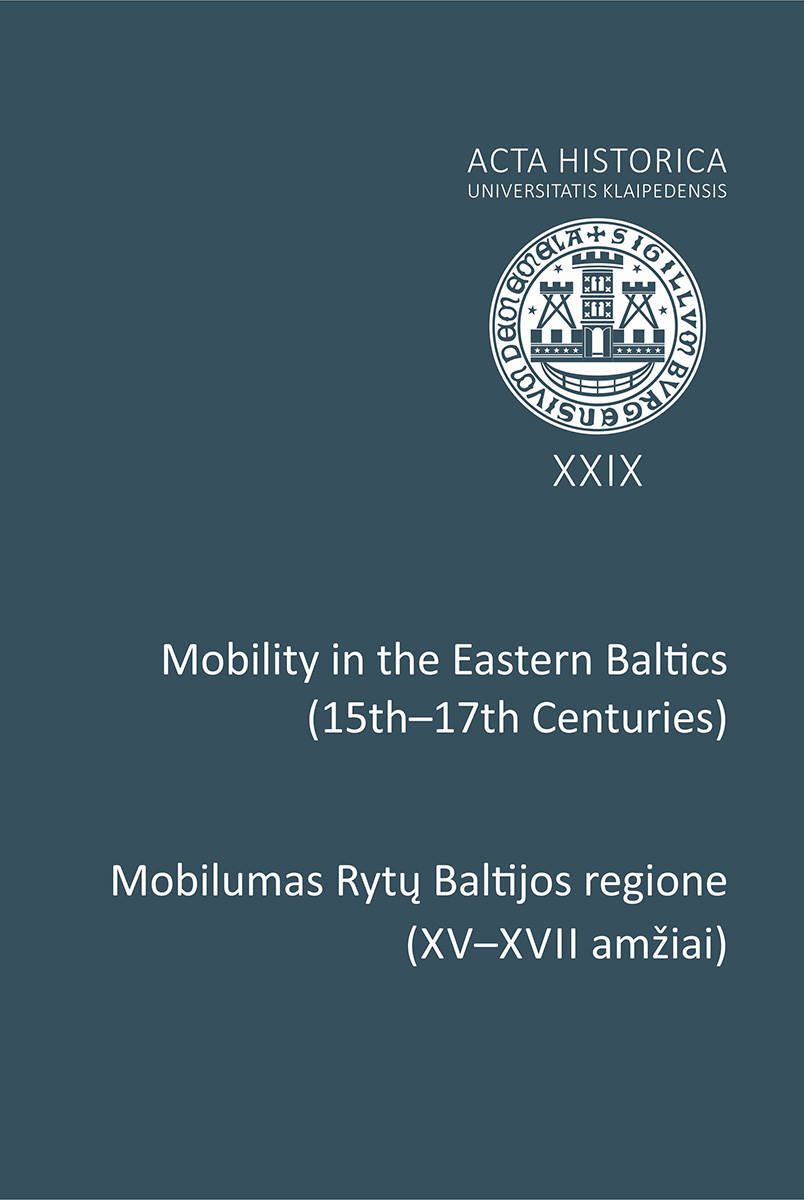Volume 29 (2014): Mobility in the Eastern Baltics (15th–17th Centuries) = Mobilumas Rytų Baltijos regione (XV–XVII amžiai), December 2014

Order by:
Pub. online: 19 Dec 2014
Type: Editorial Note
 Open Access
Open Access
Journal:
Acta Historica Universitatis Klaipedensis
Volume 29 (2014): Mobility in the Eastern Baltics (15th–17th Centuries) = Mobilumas Rytų Baltijos regione (XV–XVII amžiai), p. 5
Pub. online: 19 Dec 2014
Type: Introduction
 Open Access
Open Access
Journal:
Acta Historica Universitatis Klaipedensis
Volume 29 (2014): Mobility in the Eastern Baltics (15th–17th Centuries) = Mobilumas Rytų Baltijos regione (XV–XVII amžiai), pp. 6–10
Pub. online: 19 Dec 2014
Type: Introduction
 Open Access
Open Access
Journal:
Acta Historica Universitatis Klaipedensis
Volume 29 (2014): Mobility in the Eastern Baltics (15th–17th Centuries) = Mobilumas Rytų Baltijos regione (XV–XVII amžiai), pp. 11–15
Pub. online: 19 Dec 2014
Type: Article
 Open Access
Open Access
Journal:
Acta Historica Universitatis Klaipedensis
Volume 29 (2014): Mobility in the Eastern Baltics (15th–17th Centuries) = Mobilumas Rytų Baltijos regione (XV–XVII amžiai), pp. 16–32
Abstract
Pub. online: 19 Dec 2014
Type: Article
 Open Access
Open Access
Journal:
Acta Historica Universitatis Klaipedensis
Volume 29 (2014): Mobility in the Eastern Baltics (15th–17th Centuries) = Mobilumas Rytų Baltijos regione (XV–XVII amžiai), pp. 33–52
Abstract
Pub. online: 19 Dec 2014
Type: Article
 Open Access
Open Access
Journal:
Acta Historica Universitatis Klaipedensis
Volume 29 (2014): Mobility in the Eastern Baltics (15th–17th Centuries) = Mobilumas Rytų Baltijos regione (XV–XVII amžiai), pp. 53–74
Abstract
Pub. online: 19 Dec 2014
Type: Article
 Open Access
Open Access
Journal:
Acta Historica Universitatis Klaipedensis
Volume 29 (2014): Mobility in the Eastern Baltics (15th–17th Centuries) = Mobilumas Rytų Baltijos regione (XV–XVII amžiai), pp. 75–97
Abstract
Pub. online: 19 Dec 2014
Type: Article
 Open Access
Open Access
Journal:
Acta Historica Universitatis Klaipedensis
Volume 29 (2014): Mobility in the Eastern Baltics (15th–17th Centuries) = Mobilumas Rytų Baltijos regione (XV–XVII amžiai), pp. 98–149
Abstract
Pub. online: 19 Dec 2014
Type: Article
 Open Access
Open Access
Journal:
Acta Historica Universitatis Klaipedensis
Volume 29 (2014): Mobility in the Eastern Baltics (15th–17th Centuries) = Mobilumas Rytų Baltijos regione (XV–XVII amžiai), pp. 150–170
Abstract
Pub. online: 19 Dec 2014
Type: Source Publication
 Open Access
Open Access
Journal:
Acta Historica Universitatis Klaipedensis
Volume 29 (2014): Mobility in the Eastern Baltics (15th–17th Centuries) = Mobilumas Rytų Baltijos regione (XV–XVII amžiai), pp. 173–188